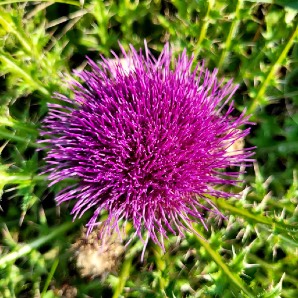Playing in the Sand: A Seasonal Diary of Restoration Work at Bunchberry Meadows - Part 1
- Cherry Dodd

- Apr 2, 2024
- 10 min read
I have been growing native plants for a long time, but it has only been in the last few years that I have had a chance to experience and work with a sandy ecosystem.
It all started five years ago at Bunchberry Meadows, a Nature Conservancy of Canada/Edmonton and Area Land Trust site close to Devon. I was invited to replant a small site that had been disturbed because of the construction of the new driveway, parking lot and washrooms.
Things quickly expanded, and there are now four restoration plots that are looked after by different people. Two plots are next to the parking lot and the two I look after are on each side of the driveway as you first enter.
There is a small pond on the south side of the driveway that was the cattle dugout when this land was a ranch. The wetland plot is the space between the pond and the driveway. The soil here is peaty and very rich thanks to years of cattle going down to the water to drink.
Across the driveway to the north is a flat, sandy area backed by a steep slope. Here the top soil was removed to make a place to park the construction machinery. So the ecosystem on this side is compacted sandy subsoil. Wow, two completely different ecosystems with different soil conditions, separated by the driveway. What an opportunity and what a challenge!
Fortunately, I have a wonderful volunteer team to help look after both of these areas, replanting them and taking out weeds. This is our fifth year of work, and I have about five volumes of material recording what we have done. However, for this article I decided to focus on just the last three months of surprises and challenges at the two plots that I look after. This article consists of the updates that I sent out to my volunteers from April through June.
April 19th, 2023
Liz and I went out yesterday to check the conditions. Work sessions always depend on the weather, especially this early in the season. The snow is completely gone and it is dry enough to walk and dig. The pond is low, but not too bad. It was teaming with water life, both below the surface and on the surface, and there was a pair of Canada geese and a pair of ducks.
The biggest surprise was the stand of common tall sunflowers. The northern pocket gophers, who moved in last year, have finally discovered them and several plants were just sticks without any roots. Several others were uprooted but had enough root left to carry on growing. We planted a few of these in the mud by the pond and I brought home two small ones to pot up.
April 30th
It was a wonderful blue-sky day at Bunchberry last Monday and we had many sandhill cranes passing overhead or circling on the thermals. Just beautiful!
We cut down the old sunflower stalks in preparation for giving some plants away, and discovered a lot more northern pocket gopher damage - some of it new. They are eating the roots and the plants are dying. So, there might not be many plants to give away. In fact, the gophers might eat all the sunflowers before moving on.
The sunflowers in the tall grass around the pond seem to be okay, and I would like to plant more at other wetlands. They attract flocks of goldfinches in the fall, and feed all types of bees in the summer. Even if the sunflowers disappear from the plot, there will be new plants sprouting from seeds, so all is not lost.
Nature is continually changing the landscape. The plots look great, so I am keeping my fingers crossed for this year. I am going to be doing lots of planting.
May 23rd
The air is better, we have had a good rain, so it is finally time to have a work bee at Bunchberry. I will not bring any plants to put in because there is no more rain in the forecast. I prefer to wait for rainier weather. We should start our rainy season in two to three weeks so I am keeping my fingers crossed.
We will be mostly weeding and checking out all the changes that have happened. I especially want to identify the sweetgrass and if I have a positive identification people can take some home. There will probably be more early blue violets to take home also because they are growing in the paths. These violets were one of the few native species already present on the prairie side when I first saw the plot and they are spreading nicely.
May 28th
The sunflowers are looking great. Although we dug out a huge amount there are still lots of clumps of plants left and lots to give away to people who want them. The ones that Sue transplanted closer to the shoreline two years ago are well-established, large clumps that are doing well. We should have our usual flock of goldfinches raiding the plants at seed time.
I couldn’t see any fresh signs of pocket gophers on the wetland side, so maybe they have moved on. I will keep my fingers crossed!
In other news, our one surviving saline shootingstar plant is in full flower and looks wonderful. Sue transplanted it closer to the shoreline a couple of weeks ago so it gets more moisture. Also on the wetland side are Philadelphia fleabanes that were already growing by the water when I was first given this area to look after. The population is healthy and growing. They were in bud and should be flowering this week. The ones I planted at the top of the bank should also be in flower.
Also flowering this week will be slender blue beardtongue, field chickweed, long-stalked chickweed, three-flowered avens, false dandelion, all the sedges, and probably a bunch of other species. We will be surprised as usual.
May 30th
It was a case of “Wildlife of the Week” at Bunchberry. Sue managed to photograph a garter snake, a specimen about half the size of the two that we spotted last year in the same spot. They seem to really like being under the tarps that are in place on either side of the wetland plot to keep the grass from encroaching.
We worked on the wetland side. I put in a few plants but it was so dry! Fortunately, Bunchberry got a good storm yesterday as we were leaving and more rain overnight.
I must find a way to capture the water as it flows down the steep slope. I am thinking that I should dig holes everywhere to catch the rain as it goes downhill. I think I will try that! I will also start bringing mulch every time I come out just for the wetland side. The ground really needs a ground cover to stop the top inch of soil from drying and repelling water. The soil is too peaty and can’t absorb water once it dries out. Maybe we should put the weeds that don’t have seeds right on the ground around the plants as mulch? I will also plant some pussytoes and native chickweed as ground cover. I am also going to add more logs to the slope to slow down the flow of water.
Juliette came out and she put in a new log barrier at the top of the bank by the sweetgrass. I think I have finally figured out how to tell the sweetgrass from the invasive grass, so Juliette also took out the invasive grass at that spot, and moved a large clump of sunflowers that were tangled in the grass. The sunflowers are now close to the pond.
Plants in flower - the blue columbine is beautiful! Also stunning was our first meadow (leafy) arnica flower. One gaillardia is in bud already and the false dandelions are covered in buds this year.
June 7th
This week the whole site was covered in poplar fluff. It even covered the surface of the pond.
Sue posted some buttercup pictures on Facebook and there was a discussion about which species they were.
The water level in the pond is really low and new plants are popping up on the newly exposed shores. On the east side, on new bare ground, there is a patch of what looks like celery-leaved buttercup. I think these are the buttercups that Sue saw. I also saw one healthy plant of Macoun's buttercup.
Planting: I brought out a few plants for the wetland side but ended up only putting in two plants, right in the mud. It was too dry to plant anything else.
There were some very large footprints from a moose in the exposed mud below our bed and some yellow evening primroses had been chomped off. The yellow evening primroses are everywhere and we have too many of them. However, I must remember not to weed them out as they are deer and moose food.
The non-native thistles are starting to grow between our bed and the pond and David did a great job of removing them. They are not as thick as last year so I think we are winning the battle. There are very few weeds in either bed, which is lovely to see.
In other news, the shootingstar has a small seed head developing! I was thinking that Wagner Natural Area would be a good place to collect shooting star seeds. Our local Edmonton population at Shooting Star Hill has shrunk to about four plants and I would like to add plants to the Bunchberry population next year.
On the west side, a little further than the shootingstar, there were two blue-eyed grasses and three very nice-looking small sedges, as well as one huge Raymond’s sedge that planted itself. I must plant more there!
At the top of the bank where the pink corydalis were last year there is one healthy plant about to bloom! Last year there were at least 30 plants of this beautiful annual, so I figured we would get a good number self-seeding this year. As usual I was wrong - only one seedling emerged this spring. Mother nature has again reminded me that she is in charge, not me.
The prairie edge, under the fence line on the prairie side, was so dry that the plants were wilting and I watered quite a bit there. The mature, well-rooted plants will wait out the drought and spring back to life after a few days of rain. However, the new transplants are not yet resilient.
June 19th
Things have been tough this year - a heatwave in May, and a prolonged drought so severe that plants were wilting and the pond was at the lowest level I have ever seen. I had over 100 plants to put in, but wanted to wait for the rainy season, so they would be watered. The ideal would be: a few showers to wet the ground, then plant, a few more showers, more planting, etc. However, mother nature had other plans. We fell overnight into constant rain, sometimes heavy every day.
Finally, last Saturday, Liz and I went out to Bunchberry and met Sue there. It was supposed to rain but we took a chance. I had a couple of trays of purple prairie-clover to plant. They were getting waterlogged sitting in my garden and I didn’t want to lose them.
Once there, we divided them up into three: some for Liz’s plot by the parking lot, some for Judith’s original plot, that Sue is now looking after, and some for both sides of the driveway. We got about half planted before we had to plant the rest in the rain. We got soaked but it was worth it!
Both sides of the driveway are looking great after a week of rain. There is a huge patch of gaillardia in bloom on the hillside and a corresponding patch in bloom on the wetland side. The lilac-flowered beardtongue patch was in full flower and looked great.
The pond was back to normal levels and goldfinches were already checking out the sunflowers looking for seeds. On the prairie side the white evening-primrose was in bloom and looking fabulous. It took three years for three small seedlings to settle in, but now it has taken off, spreading up the hillside and also down into the upper path. The rhombic-leaved sunflowers are finally spreading and so is the golden bean.
It feels as though the plants are finally settling in and getting used to the unpredictable conditions. Ground coverage is a lot better this year and I am looking forward to more exciting developments.
June 22nd
Bunchberry was amazing today. The gaillardias by our lunch spot on the wetland side are in full bloom and covered in butterflies. There were several different species and it was wonderful to see them all cruising around. I have never thought of gaillardia as being irresistible to butterflies, but I guess they are.
The pond is back to normal levels finally and there is a new species in bloom by the water’s edge. I have to get it identified.
Several tree swallows were flying over the pond looking for insects - no mosquitoes yet thanks to them.
June 25th
We got a lot planted, David did a great job on the thistles and other weeds, and Adrian brought three sedges (Raymond’s, golden and fox sedges), which we put in close to the water.
Liz R. arrived with another donation of a large clump of blue-eyed grass. Thanks Liz! She donated all the blue-eyed grass that is planted along the fence line on the wetland side and it is doing well. We will have lots of seeds.
We also found a lovely caterpillar on a tiny cow parsnip plant. The caterpillar is destined to become one of the swallowtails. I must remember to make sure we have several cow parsnip plants each year. Usually, they self-seed but maybe it was too dry this year. I am going to see if I have any seedlings in my garden that I can transplant.
Also, David spotted a garter snake and a small rodent by the bottom of the tarp. He hoped they didn’t spot each other!
More news - the pond is above the high-water mark - so nice to see, and I saw the first duckweed. Probably one of the ducks brought it in. That is how it usually spreads. The more diversity the better.
June 29th
Sue lives locally, so she is out at Bunchberry nearly every day. We don’t have a water supply so Sue trucks in water from her large collection of rain barrels. She waters the new transplants, and plants that are struggling, and she has saved so many plants over the years.
Mature plants can usually survive a dry spell by regrowing from their root system, but transplants haven’t had the chance to develop a good system and are vulnerable.
Sue says about her latest visit:
"Lots of yellow blooms everywhere now. The sunflowers are beginning to open. The monarda is in full bloom in Judith's area and on the pond side. It's funny, all along your path, Cherry, are all sorts of things - a tiny gaillardia in bloom, a meadow blazingstar in bud, lots of small evening-primrose plants - self-seeded in straight sand. Amazing.
Liz - your sedges and grasses are lovely, with golden-asters, and gaillardia throughout. I walked to the boardwalk yesterday and was happy to see veronica [American brooklime] on both sides of the walkway. Lots of [marsh] skullcap, tufted loosestrife and sedges in bloom.”
So next time I am out at Bunchberry we will take a trip to the boardwalk.
Sue also said on Facebook that the Drummond’s thistles are in flower! So, we will go and see them too.
The adventure continues!
Cherry wishes to thank her great team of volunteers for all their work. If you would like to volunteer at Cherry’s native plant plots at Bunchberry Meadows, please send an email to volunteer@enps.ca. Work bees are usually 12 noon to 3 pm on Mondays (even during park closures, but not during winter).














